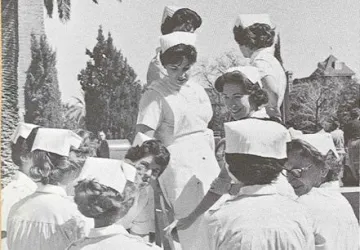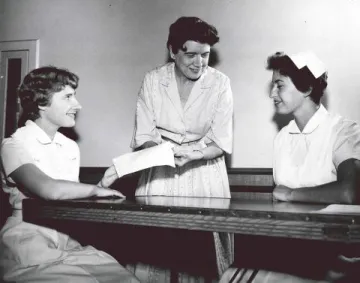
The University of Arizona College of Nursing was established in 1957.
Early Foundations of Nursing Education in Arizona (Pre 1957)
Formal nursing education arrived in Arizona when St. Joseph's Hospital in Phoenix established a three-year diploma program. By 1944, five Arizona hospitals offered similar programs. In 1950, a U.S. Public Health Service survey found a significant nursing shortage in Arizona and underscored the need for expanded nursing education in the state. During the 1950s, two organizations helped organize and consolidate regional nursing education: the Western Conference for Higher Education in Nursing (WCHEN) and the Western Interstate Commission for Higher Education (WICHE), the latter serving as a clearinghouse for regional programs in medicine, dentistry, veterinary medicine, and nursing.
In the early 1950s, Arizona’s governor and university presidents began discussing the need for a baccalaureate nursing program. At the same time, Pearl Parvin Coulter, a University of Colorado faculty member, traveled regularly to Good Samaritan Hospital in Phoenix to teach public health nursing. By 1955, Arizona was the only U.S. state without a baccalaureate nursing program. Clinical facilities were limited; Coulter later described them as “primitive,” noting that Tucson Medical Center had termites in the beams of its pediatric unit and even reported a bull snake entering a patient room.

The original nursing cap–suggestive of a mantilla, mountains, and a saguaro cactus–designed by George Harvill, the wife of then UA president Richard Harvill.
Founding the School of Nursing (1957)
In 1957, the Arizona Board of Regents approved the establishment of the School of Nursing and placed it within the University of Arizona’s College of Liberal Arts. President Richard Harvill appointed Pearl Parvin Coulter, MS, RN, of Denver, Colorado, as the School’s first director. Coulter brought more than 20 years of experience teaching public health nursing in an academic setting and had served as head of the Public Health Nursing Section at the University of Colorado School of Nursing.
That same year, 42 students enrolled in the University of Arizona’s new Bachelor of Science in Nursing (BSN) program, and Agnes Aamodt, PhD, RN, FAAN, was appointed the school’s first faculty member. The program’s initial budget totaled approximately $23,000.
The school’s first home was a conference room in the Liberal Arts Building. Early expansion was modest yet rapid, beginning with a laboratory in the new Biological Sciences Building. Tucson Medical Center served as the school’s first clinical site, and clinical practicum experiences formally began in 1959.
The original nursing student uniform consisted of a pink-and-white pinafore (an apron-like garment), a cap, and a pin. The cap, which evoked a mantilla, mountains, and a saguaro cactus, was designed by George Harvill, the wife of then-UA President Richard Harvill.
Building Programs and Early Growth (1959–1964)
By 1960, the first Skills Laboratory was established in the basement of the Home Economics Building, equipped with hospital beds and equipment to teach technical nursing skills. In 1961, the National League for Nursing accredited the BSN program, and in May of that year, the University of Arizona awarded its first Bachelor of Science in Nursing degrees to ten graduates.
The school demonstrated a strong commitment to inclusion and global perspectives early on. Professor Coulter actively recruited international and minority students, and in 1961, the first two students from Mexico enrolled in the program.
In 1963, the school established its first honors program for nursing students. In 1964, the Arizona Board of Regents designated the School of Nursing as an autonomous college within the university system. As a newly independent College of Nursing, it quickly emerged as a leader in continuing education, sponsoring numerous statewide programs for nurses.
Embracing the Community
From its earliest years, the College of Nursing embodied Professor Coulter’s vision of nursing as both a science and an art. She emphasized continuity of patient care within the family, clinical nursing research, cross-cultural perspectives, and community outreach. Coulter believed nurses should have patient-centered learning experiences and care for patients “wherever they happened to be,” while also being prepared for academic, administrative, and research careers.
During its first summer session, the school sponsored WCHEN continuing education courses on nursing leadership and hosted a conference on child development and family life. Throughout the 1960s, the college offered conferences on tuberculosis nursing, cultural and ethnic factors in nursing, work satisfaction, school nursing, nursing home administration, and other emerging issues.
In collaboration with the School of Home Economics, the college offered a cross-cultural health seminar series featuring healers from Native American and Mexican traditions. Faculty research during this period included the influential study “Cultural Components in Public Health Nursing,” which examined health beliefs and practices on the San Xavier Reservation. This work culminated in the publication of the guidebook “Cultural Components: A Manual for Nurses.”
Expansion of Facilities and Academic Programs (1965–1975)
Rapid enrollment growth soon required additional space. In 1959, the school relocated to the basement of the new Home Economics Building and later expanded into space in the U of A stadium building and a former real estate office near campus. By 1963, enrollment had reached 200 students, supported by clinical agreements with ten Tucson-area health care facilities, including hospitals, the county health department, and the Tucson Visiting Nurses’ Association.
In 1967, the Arizona Board of Regents approved the Master of Science in Nursing degree. That same year, Gladys E. Sorensen, EdD, RN, FAAN, was appointed the college’s second dean, and construction began on the new College of Nursing building. The Division of Nursing within the U.S. Department of Health, Education, and Welfare also selected the University of Arizona as one of seven institutions nationwide to offer a Nurse Scientist program, laying the groundwork for the college’s future PhD program.
The first class of Master of Science (MS) students was admitted in 1968, and by 1970, the university awarded its first MS degrees in Nursing. The National League for Nursing accredited the master’s program in 1970.
Advancing Research, Practice, and Outreach (1970s)
In the early 1970s, College of Nursing faculty traveled across Arizona to provide education for nurses in rural and underserved communities. The college launched advanced practice and nurse specialist programs in pulmonary, oncology, primary care, adult, geriatric, neonatal, and family nurse practitioner practice. Nurse practitioner education began at Tucson’s El Rio Neighborhood Health Center and later expanded into additional specialties.
In 1972, the college established the Katie Ugo Health Center at the Armory Park Senior Center, further strengthening its community presence. Research activity expanded rapidly, and in 1973, the college organized a nursing research conference that evolved into an international symposium, one of the first of its kind in the United States.
In 1975, the Arizona Board of Regents approved the state’s first Doctor of Philosophy (PhD) program in Nursing at the University of Arizona, making it the first such program west of the Mississippi River. The college also established its first Office of Nursing Research to support doctoral education and faculty scholarship.
Continuing Growth, National Recognition, and Ongoing Vision
Through the late 1970s and 1980s, the College of Nursing expanded its research infrastructure, facilities, and academic offerings, including the addition of a fourth floor to the college's building in 1976. The Alumni Council was established in 1982, as part of the college’s 25th anniversary, to strengthen alumni engagement and scholarship support.
The college’s national reputation continued to grow through leadership in nursing research, innovative educational models, and strong community partnerships, building on the enduring vision of Pearl Parvin Coulter.
Today, as the College of Nursing continues to grow and evolve, the foundational principles articulated by its first dean remain central: patient-centered education, community engagement, cultural understanding, and advancing nursing science through research and scholarship. The college's history reflects a sustained commitment to improving health and advancing the nursing profession in Arizona and beyond. 2027 will mark the college's 70th anniversary!

